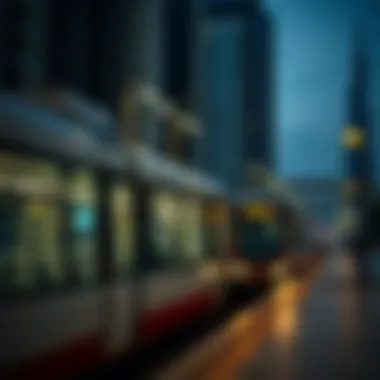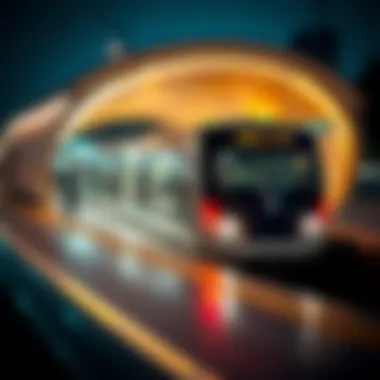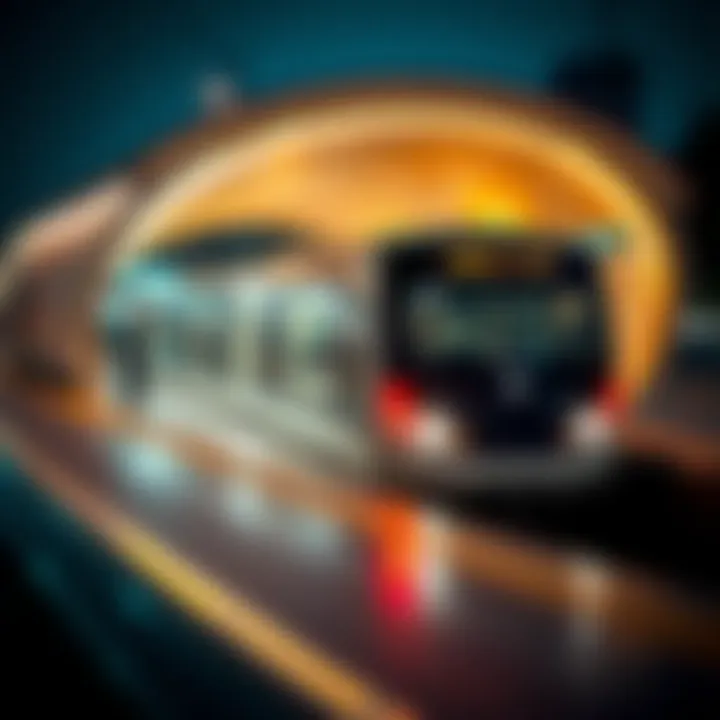Understanding Metro Working Hours in Dubai


Intro
In the bustling metropolis of Dubai, public transportation plays a crucial role in connecting its residents and visitors to a world of opportunities. Among the many transit options available, the metro system stands out due to its efficiency and convenience. However, understanding the working hours of the metro is fundamental for anyone who wishes to navigate the city effectively. The operational timings not only affect daily commuters but also influence the flow of various social and economic activities.
Dubai’s metro operates on a schedule tailored to accommodate the needs of a diverse population. This dynamic nature reflects the ongoing shifts in both local culture and global influences, necessitating a closer examination of the timelines and peak periods. Factors such as special events, seasonal variations, and the overall growth of the metro system directly impact how residents and tourists experience transportation across the city.
By immersing ourselves in the intricacies of metro working hours, we can appreciate how they align with Dubai’s broader transportation strategy. This article seeks to dissect these timings and their implications, offering a detailed guide on the working hours of the metro while considering the intricate relationship between the metro system and the emirate’s ever-evolving landscape.
As we delve deeper, we will explore seasonal patterns and integration with real estate trends in Dubai. Whether you're a tourist planning your itinerary or a resident going about your daily routine, understanding these operational hours can enhance your experience in this vibrant city.
Overview of Dubai Metro
Dubai Metro stands as a cornerstone of the city’s transportation landscape, indicating a significant shift towards modern urban mobility solutions. Developed as a rapid transit system, it not only provides an efficient way to navigate the bustling metropolis but also reflects the broader vision for sustainable urban development. The establishment of the metro system has dramatically altered commuting dynamics for residents and tourists alike, making it a focal point in understanding public mobility in Dubai.
Foreword to the Metro System
Launched in 2009, the Dubai Metro has quickly become a defining feature of the city's skyline and infrastructure. With its striking design and high-speed capabilities, the metro connects key areas, allowing for seamless travel across the city. The Red Line stretches from Rashidiya to UAE Exchange, while the Green Line spans from Etisalat to Dubai Healthcare City, catering to diverse neighborhoods and commercial hubs. This thoughtful layout underscores how the metro system has matured from a conceptual vision into a practical solution to transport challenges in one of the fastest-growing cities in the world.
Significance of the Metro in Urban Mobility
The metro is more than just a mode of transport; it symbolizes the commitment of Dubai to enhance urban living standards. By drastically reducing congestion on the roads, it plays a pivotal role in promoting smoother flow of traffic. This serves not just vehicular traffic but also emphasizes pedestrian safety and accessibility. Riders enjoy the benefits of time savings, as the metro traverses routes that are often congested, providing a quicker alternative compared to traditional transport methods. Moreover, the significant investment in this transportation facility reflects a broader commitment from local governments toward developing a sustainable and supportive urban environment.
Metro Technology and Innovation
At the heart of the Dubai Metro's functionality are cutting-edge technologies that ensure efficiency and safety. With fully automated trains and sophisticated control systems, the operation is streamlined and reliable. Each train is equipped with systems designed to enhance passenger experience, including air conditioning and real-time information displays. Moreover, smart ticketing solutions, such as the Nol card, allow riders to traverse multiple transportation modes with ease, thereby integrating the metro into the broader network of public transport options. This forward-thinking approach aligns with global trends in mass transit systems, posing Dubai as a leader in mobility innovation within the region.
"The Dubai Metro is not just about getting from point A to point B; it's about rethinking how a city can move, grow, and thrive in a rapidly changing world."
In sum, the Overview of Dubai Metro highlights its indispensable role in urban transportation and its significance in everyday life, making it crucial for savvy investors and stakeholders to understand the implications of metro working hours and the broader transport strategies at play.
Metro Working Hours
Metro working hours are a crucial aspect of the Dubai Metro system, influencing not only commuting habits but also overall accessibility within the vibrant city. Understanding these hours benefits a wide audience, including residents, tourists, and particularly those involved in real estate and urban planning. Efficient metro hours align with the needs of daily commuters and contribute significantly to reducing traffic congestion in a rapidly urbanizing environment. The smoother commute fosters economic productivity and enhances the quality of life in the city, making it a focal point for investors and businesses alike.
Standard Working Hours
Standard working hours for the Dubai Metro typically begin at 5 AM and end at midnight on weekdays. This operational window provides ample opportunity for commuters to navigate the city efficiently, whether they're heading to work, school, or leisure activities. The timing also coincides with the varied schedules that many residents maintain, catering to both early risers and night owls alike. Additionally, by having a defined schedule, the metro promotes an organized environment for its passengers.
A notable feature regarding the standard hours is the incremental adjustments made when necessary. These adjustments can be due to maintenance or infrastructural improvements that ensure the system remains functional, thus enhancing safety and operational efficiency. Consistency is key for commuters, and the metro's adherence to set hours can be a significant factor in their daily planning.
Operational Hours During Weekdays
During weekdays, the operational hours are finely tuned to support the flow of the morning and evening rush hours. From Sunday to Thursday, the metro services are in high demand during the mornings between 7 AM and 9 AM, as workers head into the business districts. In the evenings from 5 PM to 8 PM, the metro experiences another surge as individuals conclude their workdays and head home.
These enforceable time frames play a vital role in urban mobility, allowing commuters to plan effectively. It is wise for new riders to familiarize themselves with these busy periods to avoid the hustle and bustle that can come with rush hour. One interesting fact to note is that the Dubai Metro has succeeded in accommodating a staggering number of passengers daily, with estimates often surpassing a half-million riders. It serves as a testament to the city's commitment to fostering effective public transport.
Saturday and Sunday Schedules


Weekends in Dubai, particularly Friday and Saturday, typically see a shift in metro hours. While the metro operates shorter hours on Fridays, beginning later in the morning from 10 AM until midnight, Saturday follows a more traditional weekday schedule. The change reflects local customs, particularly the observance of Friday as a holy day leading into the weekend.
For visitors, this means adjusting views on when to plan city explorations. Weekend hours also allow tourists to enjoy the sights without the pressure of weekday rushes. This flexibility of operational hours serves both residents and visitors and encourages the use of public transport for weekend leisure activities. Notably, both Friday and Saturday provide specific attractions that benefit from extended operational hours, enhancing the cultural experience of commuting through the city.
For further insights into the metro's function and strategic importance in Dubai's public transport network, one can explore more at Wikipedia or the Dubai Roads and Transport Authority.
In summary, recognizing the operational paradigms of the metro allows all stakeholders to navigate the intricate web of urban life more effectively.
Peak vs Off-Peak Hours
Understanding the difference between peak and off-peak hours is crucial for both local commuters and tourists navigating Dubai's extensive metro system. The timing of travel can alter an individual's experience significantly, from wait times to discomfort levels during their journey. Knowing when the trains are likely to be crowded can help both residents and visitors better plan their travel and optimize their time spent in the city.
Identifying Peak Hours
Peak hours on the Dubai metro are generally associated with the busy times of the day when most people are commuting to and from work. On weekdays, peak hours typically fall between:
- 7:00 AM to 9:00 AM
- 5:00 PM to 7:00 PM
During these times, the metro sees a surge in commuters who are either heading to their jobs or returning home after a long day. On weekends, while the trend is somewhat different, certain periods during Saturday morning and Sunday evening can be busy, especially in areas with shopping malls or attractions. Observers note that specific stations like Union and Burj Khalifa/Dubai Mall can become particularly congested during these periods, illustrating the need for travelers to be strategic about their journeys.
Impact on Commuters
For many residents, peak hours can feel like a bustling hive of activity. Commuters frequently experience longer wait times, and the carriages can often be packed to the brim. This creates challenges such as:
- Reduced comfort: Crowded trains mean less personal space, which could be a challenge for those with mobility issues.
- Increased travel time: More people on the trains can slow the boarding process, leading to longer commutes.
Conversely, traveling during off-peak hours typically translates into a much more pleasant experience. The metro runs smoothly, and passengers can find more room to themselves. For those who can adjust their schedules, using the metro before 7:00 AM or after 7:00 PM can lead to a notably different journey.
Strategies for Avoiding Crowds
Avoiding peak hours can be a wise move for anyone looking to maximize their travel efficiency. Here are some strategies to consider:
- Plan your travel times: If you have the flexibility, try to schedule your trips outside the peak hours mentioned.
- Monitor real-time updates: Utilize apps or online services that provide real-time metro updates to check crowd levels before heading out.
- Choose less busy stations: If possible, opt for stations that typically see fewer commuters during peak hours.
Engaging with the broader flow of the metro can be as simple as adjusting your times and routes. This flexibility not only enhances your travel experience but also contributes to a more manageable and enjoyable day out in Dubai.
"Understanding the rhythm of the metro can turn an ordinary journey into a seamless experience."
For more detailed transit information and updates, consider checking the official RTA website and community discussions on platforms like Reddit or the Dubai Forum.
Seasonal Variations in Service Hours
Understanding how seasonal changes influence the service hours of Dubai's Metro is crucial for both everyday commuters and occasional users alike. With Dubai’s climate and cultural practices strongly shaping daily life, including transport schedules, recognizing these variations can help passengers plan trips more effectively. This section examines how service hours adapt to seasonal shifts, particularly during the hot summer months and the holy month of Ramadan, which carry significant implications for ridership and usage patterns.
Changes During the Summer Months
The summer in Dubai is notorious for its soaring temperatures, often hitting the high 40s in Celsius. Such extreme heat impacts not just the daily routine of residents, but also the operation of the Metro system. To ensure the safety and comfort of passengers, the metro working hours are adjusted accordingly.


- Extended Hours: Generally, the hours may see a slight extension to accommodate the needs of commuters who travel early in the morning or later at night when temperatures drop. These adjustments allow the metro to remain a preferred mode of transport when the streets are unbearable.
- Altered Frequency: During peak times, particularly from June to September, the frequency of trains might increase to manage the influx of passengers seeking relief from the heat. People prefer to minimize time spent outdoors, thus, placing more demand on the Metro service.
For example, during summer, it’s not unusual to notice the Metro running more frequently between 4 p.m. and 9 p.m. This period often sees a rush as people head to malls or dine out, steering clear of the daytime heat.
"The bustling Metro during summer months becomes a lifeline for many, offering a comfortable and air-conditioned escape from the scorching Dubai sun."
Adjustments for Ramadan
Ramadan brings unique shifts to both lifestyle and transit schedules in Dubai. As a month of fasting, it modifies the daily rhythms for Muslims and, consequently, the operational hours of the Metro are adapted to align with these changes.
- Iftar Hours: The Metro schedules typically shift to accommodate the iftar timing, when many break their fast at sunset. Consequently, the Metro often runs later into the evening to cater to individuals returning from prayers or gatherings after sunset.
- Reduced Daytime Services: During Ramadan, many businesses may operate on shorter hours, resulting in reduced weekday ridership. That said, weekend ridership can remain robust as families often come together for evening meals, hence increasing demand during these evenings.
Passengers might find that trains are busier leading up to iftar, as people rush to their destinations. Thus, understanding these adjustments aids in navigating the Metro service during this spiritually significant period.
When planning around Ramadan, it’s vital to consult the Metro’s official schedule, as timings can vary annually depending on the lunar calendar.
In summary, seasonal variations in service hours reflect a deep understanding of the population’s needs while adapting to climatic conditions and cultural practices, ultimately enhancing the city's public transportation experience.
Impact of Events on Metro Hours
Understanding the impact of events on metro hours is crucial for both residents and visitors navigating Dubai’s intricate urban transport network. It highlights how the metro adapts to meet increased demand during various occasions, ultimately improving commuter experience. With events ranging from sporting fixtures to festivals, the metro plays a pivotal role in managing mobility, ensuring seamless transport solutions in a bustling city.
Increased Service During Major Events
During significant events, the Dubai Metro often ramps up its service frequency. For instance, during major international exhibitions like the Expo 2020, additional trains are put into service to accommodate the anticipated surge in passenger numbers. This increased service not only helps in alleviating congestion on the roads but also ensures that attendees arrive at their destination on time.
- Special Schedules: The metro may operate on extended hours or special schedules, ensuring late-night services for event-goers.
- More Frequent Trains: To manage the inflow, trains might come more frequently than usual, especially during peak arrival and departure times.
- Accessibility: Enhanced metro services can also include accessible routes for senior citizens and those with disabilities, allowing everyone to participate in events with ease.
This bolstered service reflects the city’s infrastructure flexibility and proves essential for facilitating large gatherings. Events greatly influence operational decisions, and with careful planning, authorities can effectively manage ridership while preserving commuter comfort.
Implications for Regular Commuters
While increased services during events seem beneficial, they can come with implications for regular commuters. The added frequency may sometimes lead to overcrowded trains during peak hours, necessitating some adjustment in commuting patterns.
- Crowding Concerns: Regular users may encounter larger crowds, particularly before and after major events, which can make their daily commute more stressful.
- Schedule Changes: Regular timetables can shift, with events leading to altered operations, catching daily commuters off guard.
- Time Management: Commuters should plan their journeys effectively, factoring in potential delays or increased travel times due to passenger influx.
However, with such adjustments come opportunities. Regular commuters can benefit from knowing when events are happening and can plan to travel at different times. Many find the adventure of attending city events worth the trade-off in routine.
"Events not only shape the character of Dubai but also its transportation dynamics."
Integration with Residential and Commercial Developments
In the constantly evolving urban landscape of Dubai, the integration of the metro system with both residential and commercial developments represents a cornerstone of effective urban planning. This relationship is not merely a question of proximity; it encapsulates a broader vision of seamless connectivity that enhances the overall quality of life for residents and visitors alike.
Metro Accessibility in Real Estate
The accessibility of Dubai Metro is a decisive factor for many real estate developers. Properties located near metro stations rise in desirability. Prospective residents increasingly prioritize mobility options. Think about it: a quick hop on the metro can mean saving considerable time compared to being stuck in traffic.


By establishing residential towers, villas, and mixed-use complexes close to metro stations, developers can attract buyers looking for convenience. Moreover, certain communities like Dubai Marina and Downtown are not just famed for their luxurious offerings but also for their metro connectivity. It’s an attractive selling point for families, young professionals, and even retirees.
Benefits include:
- Convenience: The ability to commute effortlessly contributes to higher living standards.
- Sustainability: With reduced reliance on cars, this fosters a greener, more environmentally friendly urban ecosystem.
- Community Development: Increased foot traffic can bolster local businesses and amenities, creating vibrant neighborhoods around metro hubs.
Influence on Property Values
The impact of metro accessibility on property values cannot be overstated. Properties within a short walking distance from a metro station typically command higher rents and resale values.
Real estate agents often cite "proximity to transport links" as a key selling point. When the metro expands its reach, surrounding properties gain value.
Consider these statistics:
- 30% Increase: Properties located within a 500-meter radius of a metro station can see property values rise by 30%.
- Fast Sales: Homes near metro stations tend to sell faster than those further away, appealing to investors looking for quick returns.
It's common wisdom in the Dubai property market: the closer you are to the metro, the more you benefit. Not only does this attract international investors but also local buyers seeking to maximize their investments in Dubai's ever-changing real estate landscape.
"A well-connected metro increases accessibility, influencing buyer decisions and consequently, property values."
Therefore, understanding the integration of metro systems within residential and commercial contexts illuminates the potential for future investments and developments in Dubai’s real estate market.
Future Developments and Proposals
The future of Dubai's metro system stands as a pillar of its urban development strategy. As the city continues to grow and evolve, the metro's role in facilitating seamless transportation will only become more crucial. Enhancing the metro infrastructure not only caters to the increasing population but also aligns with Dubai's vision of sustainable urban living.
Potential Extensions of the Metro Network
In recent discussions, various proposals for extending the metro network have emerged. These extensions would significantly enhance accessibility for residents and tourists alike.
- New Routes: Plans are in motion for new lines that will connect emerging areas such as Dubai South and the Expo 2020 site. This will make travel more convenient, providing easier access to business districts, shopping centers, and leisure areas.
- Integration with Other Transport Modes: Extending the metro network isn't only about new tracks. It also includes better integration with buses, taxis, and even potentially electric scooters. This multi-modal approach can lead to a more efficient transit system.
- Environmental Considerations: As the metro expands, there is a strong emphasis on sustainability. Future projects are likely to incorporate greener technologies, such as solar panels on station rooftops, reducing the carbon footprint of the metro system.
"Enhancements in the metro network signify a commitment to not just urban transit, but to a cleaner, more efficient future for Dubai's transportation landscape."
Projected Changes in Operating Hours
Looking ahead, projected changes in the operating hours of the Dubai Metro are an essential consideration for commuters and stakeholders.
- Extended Hours on Weekends: There’s speculation that weekend operating hours might be expanded to accommodate social and recreational activities, reflecting the vibrant lifestyle that Dubai is known for.
- Adapting to Population Growth: As the city’s population increases, there may be calls for the metro to operate for longer hours during weekdays as well. This would alleviate congestion during peak commute times, allowing for a smoother flow of passengers.
- Special Operating Hours: It would not be surprising if the metro introduces special operating hours during significant events or festivals. Increased service during these times could improve accessibility for all attendees.
By addressing both expansions and adjusted service hours, the metro system remains a vital aspect of Dubai's transportation framework, continually adapting to meet the needs of its users.
Epilogue
The culmination of our exploration into the metro working hours in Dubai underscores a vital aspect of urban transit that impacts both the daily lives of residents and the overall appeal of the city to visitors. Understanding this topic is not merely an academic exercise; it has tangible effects on how effectively commuting and travel can be undertaken within this bustling metropolis.
Summary of Key Points
To revisit the essential highlights:
- Standard Working Hours: Typically, the metro operates with defined hours, ensuring accessibility throughout the day. These standard hours cater to a diverse population, from early risers to night owls, aiding in smooth mobility across the emirate.
- Impact of Peak vs. Off-Peak Hours: Recognizing the varying commuter traffic at different times can save travelers from unnecessary stress. During peak hours, trains can become quite crowded, while off-peak hours offer a more relaxed journey.
- Seasonal and Event-Based Adjustments: The operational hours are not set in stone. Seasonal changes, along with significant local events, lead to modifications in service. This adaptability ensures that the metro meets the fluctuating demands of the city.
- Integration with Real Estate Trends: The proximity to metro stations often correlates with property values. Thus, understanding working hours aids investors and buyers in making informed decisions about real estate in Dubai.
Final Thoughts on Dubai's Metro System
In wrapping up, it's important to reflect on the ongoing evolution of Dubai's metro system. As the city continues to grow and transform, the relevance of metro working hours only becomes more paramount. From a commuter's standpoint, optimizing travel time contributes to a better quality of life. Furthermore, for investors and analysts, staying abreast of how these hours align with broader urban planning strategies offers a distinct advantage in navigating Dubai's real estate landscape. As Dubai marches towards its future, the metro system remains a cornerstone of its urban fabric, connecting the dots between convenience, efficiency, and growth.







